Spatiotemporal Variations of Ocean Upwelling and Downwelling Induced by Wind Wakes of Offshore Wind Farms
Abstract
1. Introduction
2. Methodology and Data
2.1. Numerical Model
2.2. Wind Wake
2.3. Design of the Experiments
2.4. Acquisition of Thermocline Bathymetry and Wind Field Data
2.5. Theoretical Upwelling/Downwelling
3. Results
3.1. Vertical Temperature Anomalies
3.2. Changes in Thermocline Depth
3.3. Comparisons of the Results from Different Experiments
3.4. Mechanisms of the Spatially Net and the Nonlinearity of Evolution
3.5. Implications in China’s Adjacent Waters
4. Discussions
5. Conclusions
Author Contributions
Funding
Institutional Review Board Statement
Informed Consent Statement
Data Availability Statement
Conflicts of Interest
References
- Bilgili, M.; Yasar, A.; Simsek, E. Offshore wind power development in Europe and its comparison with onshore counterpart. Renew. Sustain. Energy Rev. 2011, 15, 905–915. [Google Scholar] [CrossRef]
- Li, Y.; Huang, X.; Tee, K.F.; Li, Q.; Wu, X.-P. Comparative study of onshore and offshore wind characteristics and wind energy potentials: A case study for southeast coastal region of China. Sustain. Energy Technol. Assess. 2020, 39, 100711. [Google Scholar] [CrossRef]
- Global Wind Energy Council. GWEC Global Wind. Report. 2023; Global Wind Energy Council: Brussels, Belgium, 2023. [Google Scholar]
- Bailey, H.; Brookes, K.L.; Thompson, P.M. Assessing environmental impacts of offshore wind farms: Lessons learned and recommendations for the future. Aquat. Biosyst. 2014, 10, 8. [Google Scholar] [CrossRef]
- Furness, R.W.; Wade, H.M.; Masden, E.A. Assessing vulnerability of marine bird populations to offshore wind farms. J. Environ. Manag. 2013, 119, 56–66. [Google Scholar] [CrossRef] [PubMed]
- Kikuchi, R. Risk formulation for the sonic effects of offshore wind farms on fish in the EU region. Mar. Pollut. Bull. 2010, 60, 172–177. [Google Scholar] [CrossRef]
- Wahlberg, M.; Westerberg, H. Hearing in fish and their reactions to sounds from offshore wind farms. Mar. Ecol. Prog. Ser. 2005, 288, 295–309. [Google Scholar] [CrossRef]
- Öhman, M.C.; Malm, T.; Wilhelmsson, D. The influence of offshore windpower on demersal fish. ICES J. Mar. Sci. 2006, 63, 775–784. [Google Scholar] [CrossRef]
- Wang, J.; Zou, X.; Yu, W.; Zhang, D.; Wang, T. Effects of established offshore wind farms on energy flow of coastal ecosystems: A case study of the Rudong offshore wind farms in China. Ocean. Coast. Manag. 2019, 171, 111–118. [Google Scholar] [CrossRef]
- Slavik, K.; Lemmen, C.; Zhang, W.; Kerimoglu, O.; Klingbeil, K.; Wirtz, K.W. The large-scale impact of offshore wind farm structures on pelagic primary productivity in the southern North Sea. Hydrobiologia 2018, 845, 35–53. [Google Scholar] [CrossRef]
- van Berkel, J.; Burchard, H.; Christensen, A.; Mortensen, L.; Petersen, O.; Thomsen, F. The Effects of Offshore Wind Farms on Hydrodynamics and Implications for Fishes. Oceanography 2020, 33, 108–117. [Google Scholar] [CrossRef]
- Schultze, L.K.P.; Merckelbach, L.M.; Horstmann, J.; Raasch, S.; Carpenter, J.R. Increased Mixing and Turbulence in the Wake of Offshore Wind Farm Foundations. J. Geophys. Res. Ocean. 2020, 125, e2019JC015858. [Google Scholar] [CrossRef]
- Carpenter, J.R.; Merckelbach, L.; Callies, U.; Clark, S.; Gaslikova, L.; Baschek, B. Potential Impacts of Offshore Wind Farms on North Sea Stratification. PLoS ONE 2016, 11, e0160830. [Google Scholar] [CrossRef]
- Christiansen, M.B.; Hasager, C.B. Wake effects of large offshore wind farms identified from satellite SAR. Remote Sens. Environ. 2005, 98, 251–268. [Google Scholar] [CrossRef]
- Porté-Agel, F.; Wu, Y.-T.; Chen, C.-H. A Numerical Study of the Effects of Wind Direction on Turbine Wakes and Power Losses in a Large Wind Farm. Energies 2013, 6, 5297–5313. [Google Scholar] [CrossRef]
- Dong, G.; Li, Z.; Qin, J.; Yang, X. How far the wake of a wind farm can persist for? Theor. Appl. Mech. Lett. 2022, 12, 100314. [Google Scholar] [CrossRef]
- Platis, A.; Siedersleben, S.K.; Bange, J.; Lampert, A.; Barfuss, K.; Hankers, R.; Canadillas, B.; Foreman, R.; Schulz-Stellenfleth, J.; Djath, B.; et al. First in situ evidence of wakes in the far field behind offshore wind farms. Sci. Rep. 2018, 8, 2163. [Google Scholar] [CrossRef]
- Hasager, C.B.; Vincent, P.; Husson, R.; Mouche, A.; Badger, M.; Peña, A.; Volker, P.; Badger, J.; Di Bella, A.; Palomares, A.; et al. Comparing satellite SAR and wind farm wake models. J. Phys. Conf. Ser. 2015, 625, 012035. [Google Scholar] [CrossRef]
- Méchali, M.; Barthelmie, R.; Frandsen, S.; Jensen, L.; Réthoré, P.-E. Wake effects at Horns Rev and their influence on energy production. In Proceedings of the European Wind Energy Conference and Exhibition, Athens, Greece, 27 February–2 March 2006; pp. 10–20. [Google Scholar]
- Pérez, C.; Rivero, M.; Escalante, M.; Ramirez, V.; Guilbert, D. Influence of Atmospheric Stability on Wind Turbine Energy Production: A Case Study of the Coastal Region of Yucatan. Energies 2023, 16, 4134. [Google Scholar] [CrossRef]
- Barthelmie, R.J.; Churchfield, M.J.; Moriarty, P.J.; Lundquist, J.K.; Oxley, G.S.; Hahn, S.; Pryor, S.C. The role of atmospheric stability/turbulence on wakes at the Egmond aan Zee offshore wind farm. J. Phys. Conf. Ser. 2015, 625, 012002. [Google Scholar] [CrossRef]
- Fischereit, J.; Brown, R.; Larsén, X.G.; Badger, J.; Hawkes, G. Review of Mesoscale Wind-Farm Parametrizations and Their Applications. Bound. Layer Meteorol. 2021, 182, 175–224. [Google Scholar] [CrossRef]
- Gonzalez-Rodriguez, A.G.; Serrano-Gonzalez, J.; Burgos-Payan, M.; Riquelme-Santos, J. Multi-objective optimization of a uniformly distributed offshore wind farm considering both economic factors and visual impact. Sustain. Energy Technol. Assess. 2022, 52, 102148. [Google Scholar] [CrossRef]
- Beesley, D.; Olejarz, J.; Tandon, A.; Marshall, J. A Laboratory Demonstration of Coriolis Effects on Wind-Driven Ocean Currents. Oceanography 2008, 21, 72–76. [Google Scholar] [CrossRef]
- Floeter, J.; Pohlmann, T.; Harmer, A.; Moellmann, C. Chasing the offshore wind farm wind-wake-induced upwelling/downwelling dipole. Front. Mar. Sci. 2022, 9, 16. [Google Scholar] [CrossRef]
- Pan, Y.; Fan, W.; Zhang, D.; Chen, J.; Huang, H.; Liu, S.; Jiang, Z.; Di, Y.; Tong, M.; Chen, Y. Research progress in artificial upwelling and its potential environmental effects. Sci. China Earth Sci. 2015, 59, 236–248. [Google Scholar] [CrossRef]
- Michler-Cieluch, T.; Krause, G.; Buck, B.H. Marine Aquaculture within Offshore Wind Farms: Social Aspects of Multiple-Use Planning. Gaia 2009, 18, 158–162. [Google Scholar] [CrossRef]
- Aryai, V.; Abbassi, R.; Abdussamie, N.; Salehi, F.; Garaniya, V.; Asadnia, M.; Baksh, A.A.; Penesis, I.; Karampour, H.; Draper, S.; et al. Reliability of multi-purpose offshore-facilities: Present status and future direction in Australia. Process. Saf. Environ. Prot. 2021, 148, 437–461. [Google Scholar] [CrossRef]
- González-Longatt, F.; Wall, P.; Terzija, V. Wake effect in wind farm performance: Steady-state and dynamic behavior. Renew. Energy 2012, 39, 329–338. [Google Scholar] [CrossRef]
- Pryor, S.C.; Barthelmie, R.J.; Shepherd, T.J. Wind power production from very large offshore wind farms. Joule 2021, 5, 2663–2686. [Google Scholar] [CrossRef]
- Yang, K.; Kwak, G.; Cho, K.; Huh, J. Wind farm layout optimization for wake effect uniformity. Energy 2019, 183, 983–995. [Google Scholar] [CrossRef]
- Baidya Roy, S. Can large wind farms affect local meteorology? J. Geophys. Res. 2004, 109, D19101. [Google Scholar] [CrossRef]
- Golbazi, M.; Archer, C.L.; Alessandrini, S. Surface impacts of large offshore wind farms. Environ. Res. Lett. 2022, 17, 064021. [Google Scholar] [CrossRef]
- Broström, G. On the influence of large wind farms on the upper ocean circulation. J. Mar. Syst. 2008, 74, 585–591. [Google Scholar] [CrossRef]
- Lian, Z.; Liu, K.; Yang, T. Potential Influence of Offshore Wind Farms on the Marine Stratification in the Waters Adjacent to China. J. Mar. Sci. Eng. 2022, 10, 1872. [Google Scholar] [CrossRef]
- Pickett, M.H.; Paduan, J.D. Ekman transport and pumping in the California Current based on the U.S. Navy’s high-resolution atmospheric model (COAMPS). J. Geophys. Res.-Ocean. 2003, 108, 3327. [Google Scholar] [CrossRef]
- Paskyabi, M.B. Offshore Wind Farm Wake Effect on Stratification and Coastal Upwelling. Energy Procedia 2015, 80, 131–140. [Google Scholar] [CrossRef][Green Version]
- Segtnan, O.H.; Christakos, K. Effect of Offshore Wind farm Design on the Vertical Motion of the Ocean. Energy Procedia 2015, 80, 213–222. [Google Scholar] [CrossRef]
- Paskyabi, M.B.; Fer, I. Upper Ocean Response to Large Wind Farm Effect in the Presence of Surface Gravity Waves. Energy Procedia 2012, 24, 245–254. [Google Scholar] [CrossRef]
- Raghukumar, K.; Nelson, T.; Jacox, M.; Chartrand, C.; Fiechter, J.; Chang, G.; Cheung, L.; Roberts, J. Projected cross-shore changes in upwelling induced by offshore wind farm development along the California coast. Commun. Earth Environ. 2023, 4, 116. [Google Scholar] [CrossRef]
- Fischereit, J.; Larsén, X.G.; Hahmann, A.N. Climatic Impacts of Wind-Wave-Wake Interactions in Offshore Wind Farms. Front. Energy Res. 2022, 10, 881459. [Google Scholar] [CrossRef]
- Christiansen, N.; Daewel, U.; Djath, B.; Schrum, C. Emergence of Large-Scale Hydrodynamic Structures due to Atmospheric Offshore Wind Farm Wakes. Front. Mar. Sci. 2022, 9, 818501. [Google Scholar] [CrossRef]
- Locarnini, R.A.; Baranova, O.K.; Mishonov, A.V.; Boyer, T.P.; Reagan, J.R.; Dukhovskoy, D.; Seidov, D.; Garcia, H.E.; Bouchard, C.; Cross, S.; et al. World Ocean Atlas 2023, Volume 1: Temperature. A. Mishonov Technical Ed. NOAA Atlas NESDIS. 2023; in preparation. Available online: https://www.ncei.noaa.gov/access/world-ocean-atlas-2023/ (accessed on 4 May 2023).
- Hao, J.; Chen, Y.; Wang, F.; Lin, P. Seasonal thermocline in the China Seas and northwestern Pacific Ocean. J. Geophys. Res. Ocean. 2012, 117, C02022. [Google Scholar] [CrossRef]
- QSCAT/NCEP Blended Ocean Winds from Colorado Research Associates (Version 5.0). Available online: http://rda.ucar.edu/datasets/ds744.4/ (accessed on 4 October 2021).
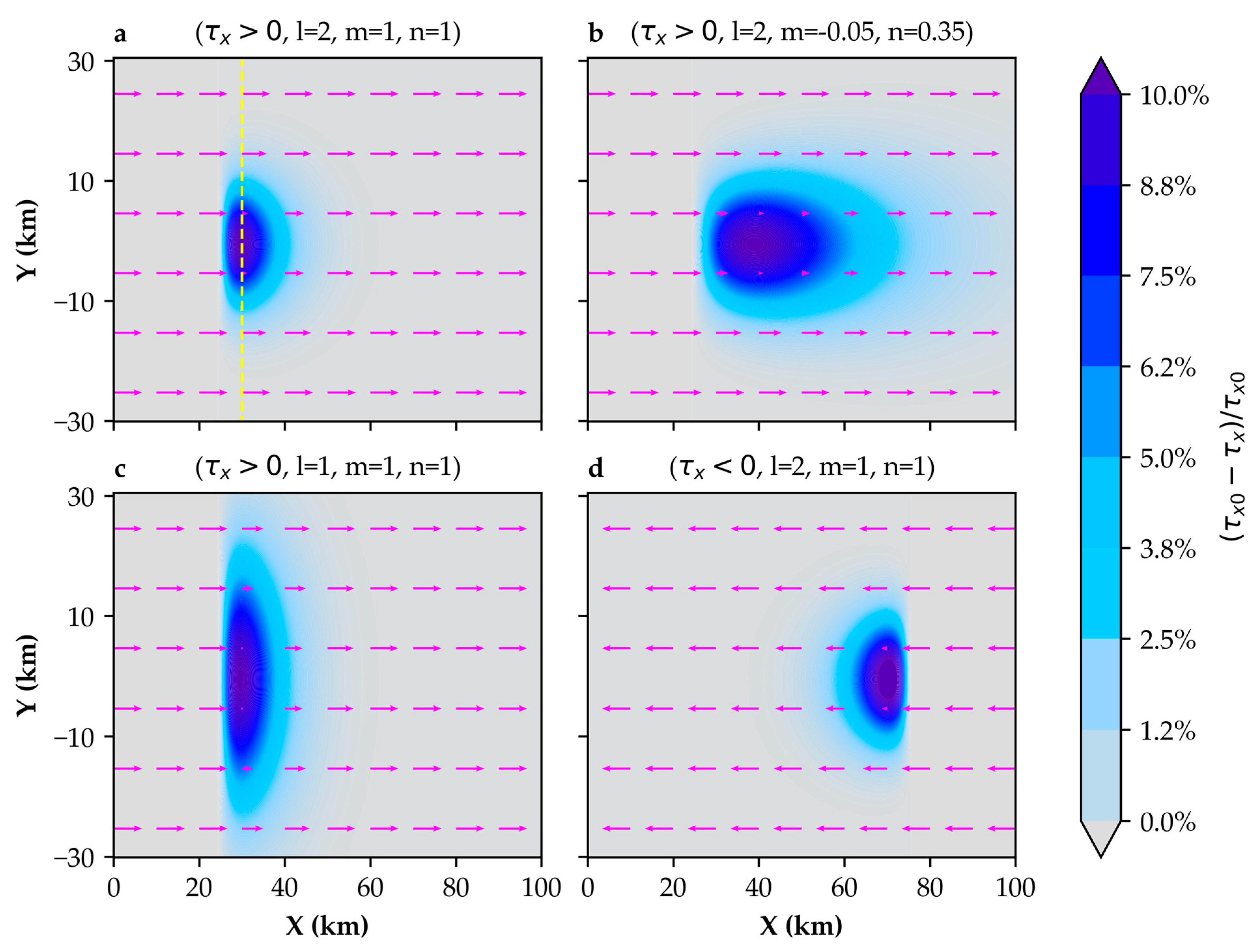

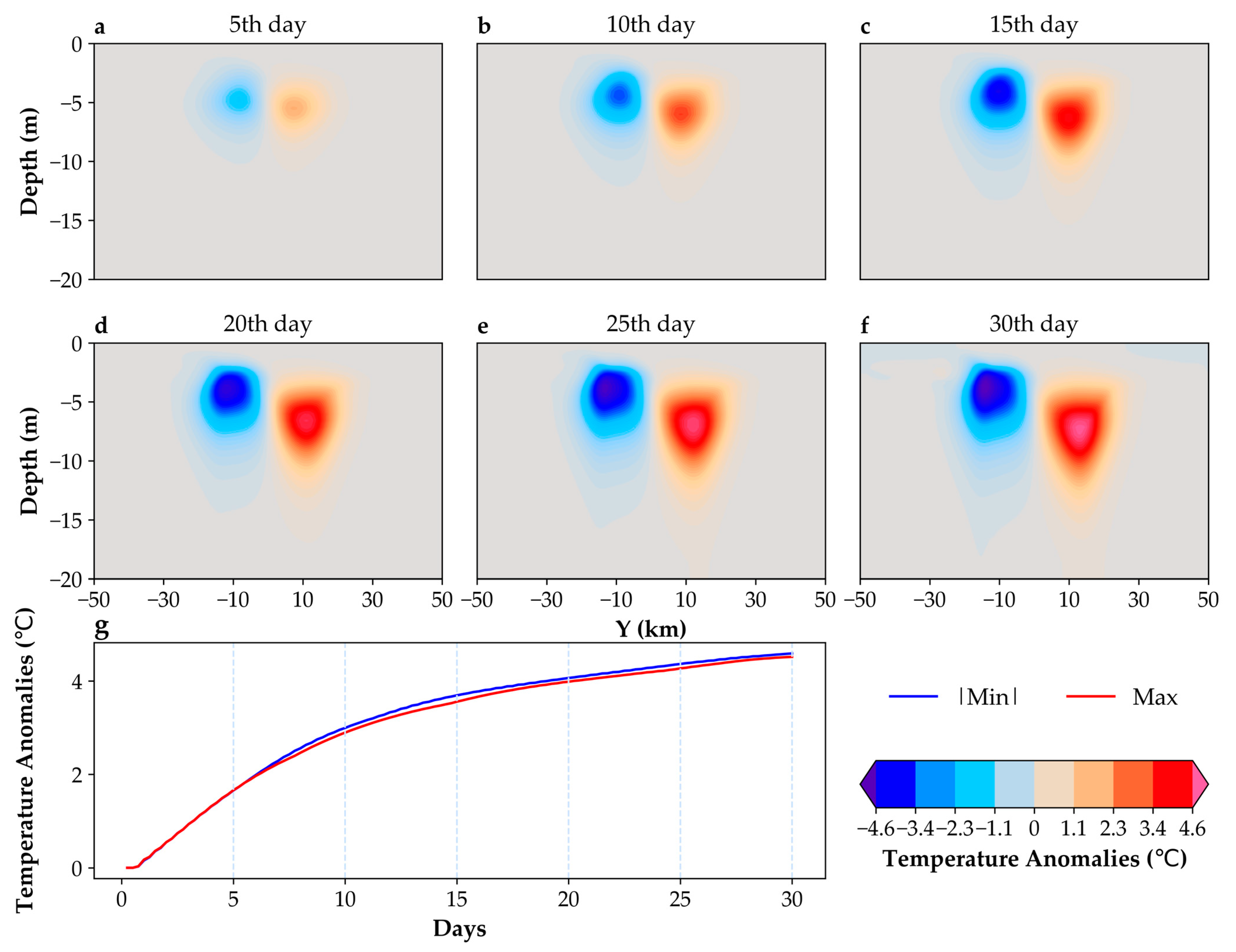

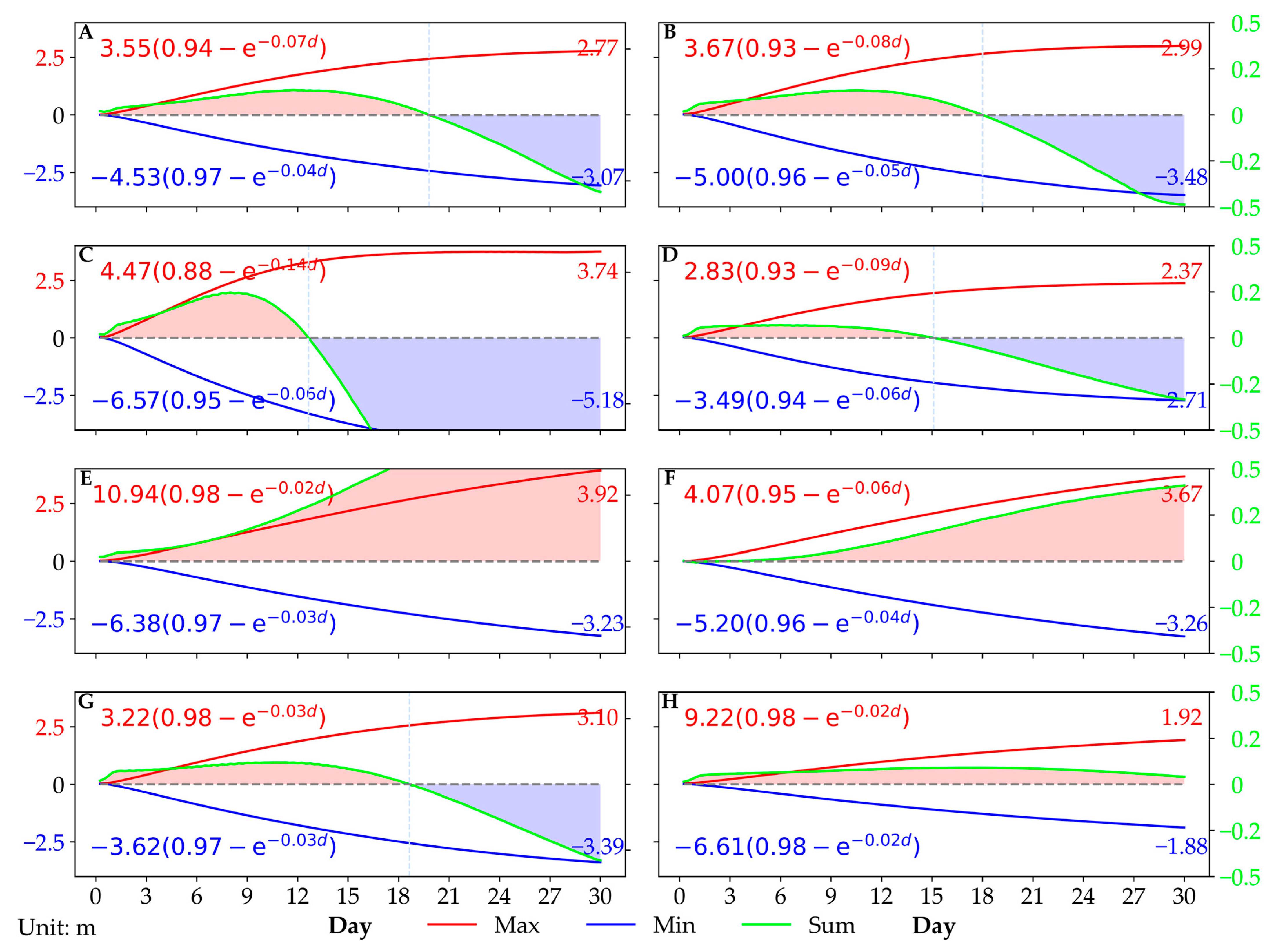

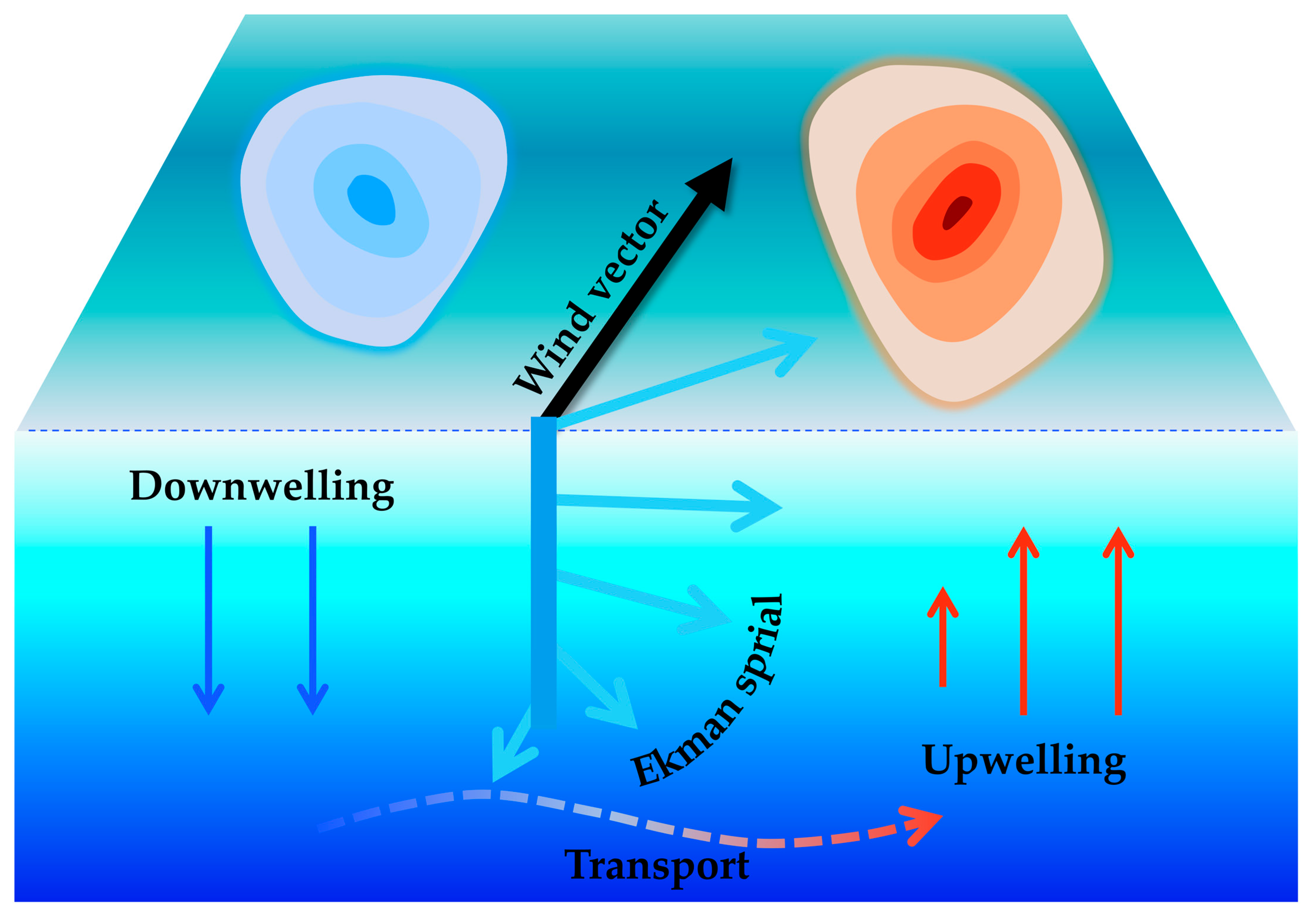

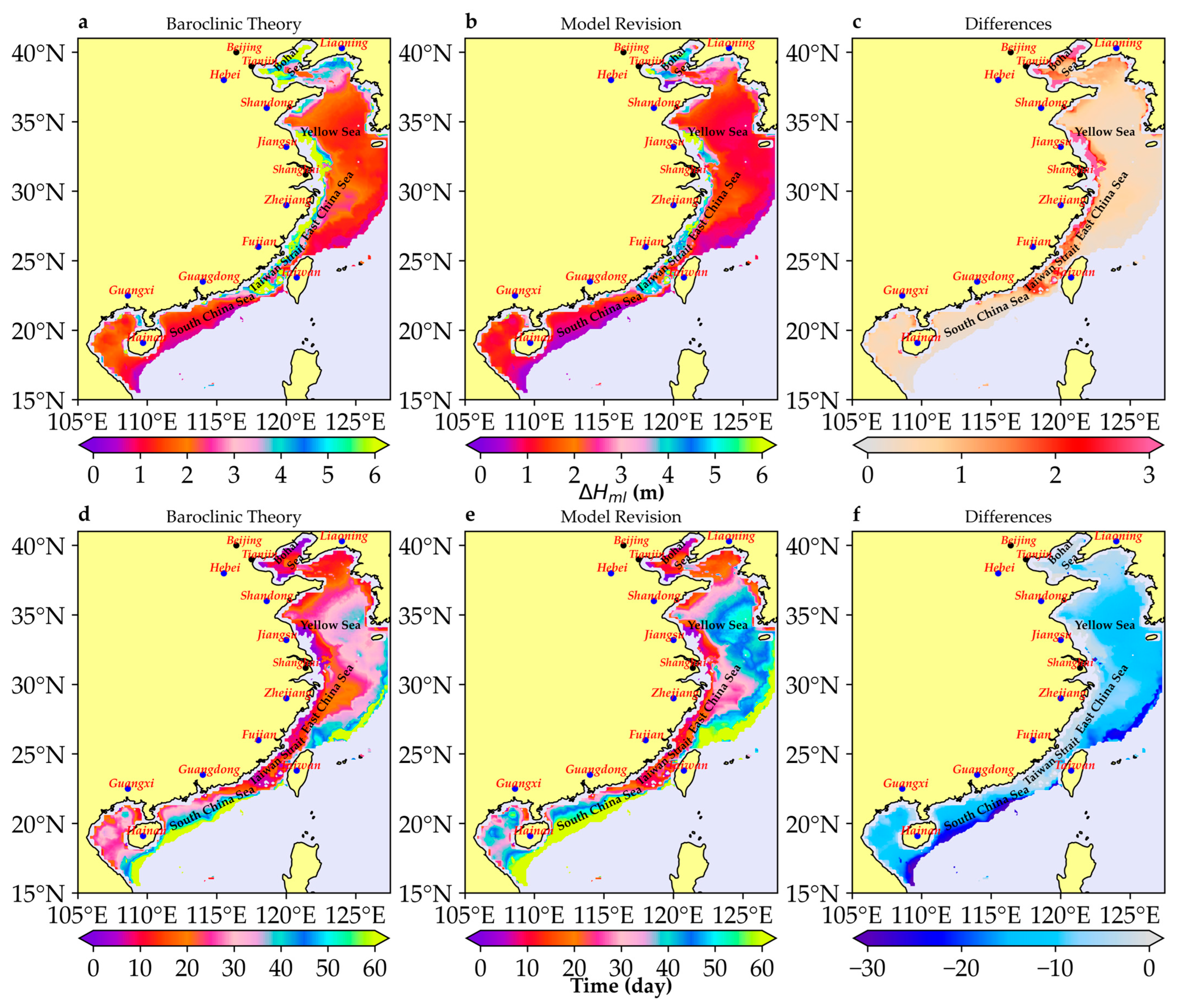
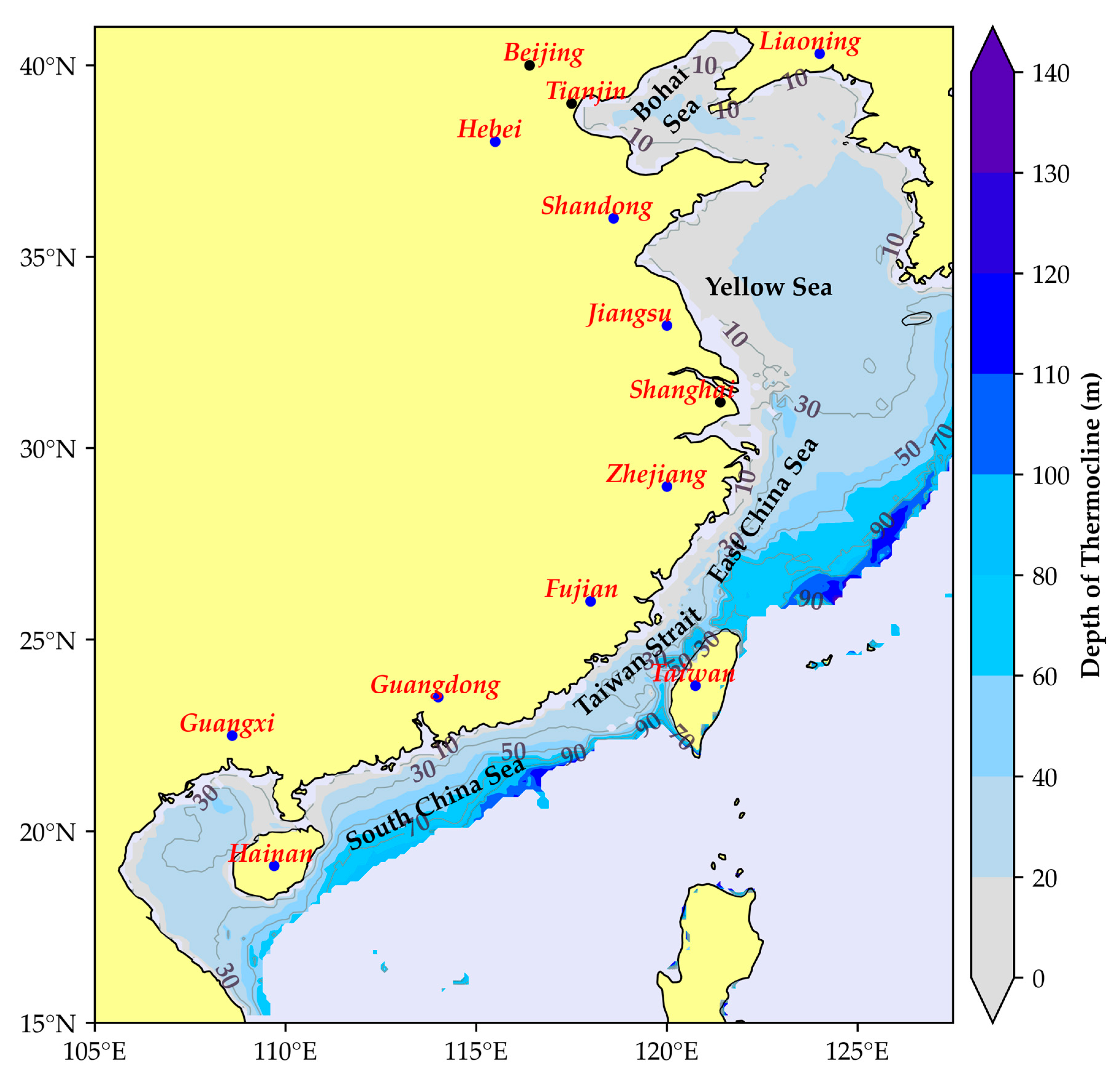
| Exp. | Wake Shape | Description | |||
|---|---|---|---|---|---|
| A | Figure 1a | 0.05|0.005 | 5.25 | 20|10 | Reference |
| B | Figure 1a | 0.06|0.006 | 5.25 | 20|10 | High wind stress |
| C | Figure 1a | 0.05|0.01 | 5.25 | 20|10 | High wind reduction |
| D | Figure 1a | 0.05|0.005 | 5.25 | 20|15 | Weak stratification |
| E | Figure 1a | 0.05|0.005 | 10.25 | 20|10 | Deep thermocline |
| F | Figure 1d | −0.05|−0.005 | 10.25 | 20|10 | East wind |
| G | Figure 1b | 0.05|0.005 | 5.25 | 20|10 | Long wake |
| H | Figure 1c | 0.05|0.005 | 5.25 | 20|10 | Wide wake |
Disclaimer/Publisher’s Note: The statements, opinions and data contained in all publications are solely those of the individual author(s) and contributor(s) and not of MDPI and/or the editor(s). MDPI and/or the editor(s) disclaim responsibility for any injury to people or property resulting from any ideas, methods, instructions or products referred to in the content. |
© 2023 by the authors. Licensee MDPI, Basel, Switzerland. This article is an open access article distributed under the terms and conditions of the Creative Commons Attribution (CC BY) license (https://creativecommons.org/licenses/by/4.0/).
Share and Cite
Liu, K.; Du, J.; Larsén, X.G.; Lian, Z. Spatiotemporal Variations of Ocean Upwelling and Downwelling Induced by Wind Wakes of Offshore Wind Farms. J. Mar. Sci. Eng. 2023, 11, 2020. https://doi.org/10.3390/jmse11102020
Liu K, Du J, Larsén XG, Lian Z. Spatiotemporal Variations of Ocean Upwelling and Downwelling Induced by Wind Wakes of Offshore Wind Farms. Journal of Marine Science and Engineering. 2023; 11(10):2020. https://doi.org/10.3390/jmse11102020
Chicago/Turabian StyleLiu, Kun, Jianting Du, Xiaoli Guo Larsén, and Zhan Lian. 2023. "Spatiotemporal Variations of Ocean Upwelling and Downwelling Induced by Wind Wakes of Offshore Wind Farms" Journal of Marine Science and Engineering 11, no. 10: 2020. https://doi.org/10.3390/jmse11102020
APA StyleLiu, K., Du, J., Larsén, X. G., & Lian, Z. (2023). Spatiotemporal Variations of Ocean Upwelling and Downwelling Induced by Wind Wakes of Offshore Wind Farms. Journal of Marine Science and Engineering, 11(10), 2020. https://doi.org/10.3390/jmse11102020







